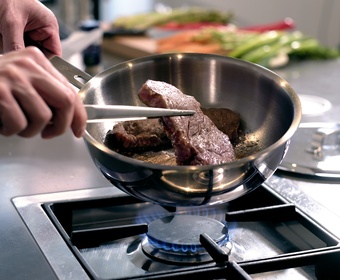About kitchen tweezers
Enlarged tweezers extend your hand so you can easily – and with precision – grip hot food without harming yourself. Many capable home cooks have yet to discover this universal kitchen tool, which is surprising. It is practical, easy to use, hygienic, easy to clean, durable and attractive.
Everyone uses tweezers, a great all round-picking-instrument.
– Chef de Cuisine Micke Björkman, Restaurant Agnes
Used all round
Tweezers can be used to grip almost anything in the kitchen: Meat in a frying pan, pasta in boiling water, spices to be removed from the pot, chicken wings on a grill, hot tomato skins to be peeled, steamed mussels that won’t open, etc.
Easy grip
Good tweezers provide a steady grip even when handling heavy food – while remaining stable and requiring little effort to “pinch”.
Use the point
It is quite alright to spear the food with the point of the tweezers. Among many other things, this tool can be your stand-in grill fork.
Steel requires steel
Proper tweezers should be made of steel. But this requires using bowls, pans and pots also made of steel or other durable materials.
Stability is key
Cooking is often about handling the heat. With stable tweezers, the chef can handle hot food safely and with precision, without the risk of getting burnt.
Some hot tips
- Water for pasta boils at 100°C.
- Barbecuing takes place between 80 and 120°C, where 110°C might be considered optimal. (Under 80°C is what constitutes “cold smoking”.)
- A suitable temperature for frying is from 140 to 180°C.
- A perfect temperature for deep frying is between 160 and 180°C.
- Grilling often takes place between 150 and 200°C.
- From 230 to 300°C the grill is too hot for cooking – unless the chef is looking for a burnt, rather than charred, surface.
A clean material
Kitchen tools made from 100 percent steel are perfect for handling food. The material is durable, sustainable and easy to clean. There is no risk of undesired substances or particles ending up in your food.
No fingers in food
Using your fingers to pluck pickled foods or food that is cooling before storage leads to immediate contamination. With clean tweezers, you no longer have a problem.
Right and wrong
Very slim tweezers – and especially plastic tweezers – tend to “scissor” when you grasp a heavy object. A perfect balance between flexibility and rigidity requires the right design and the right material.
Clean and dry
Clean and dry tweezers are better tweezers.
Fry it right
- Use a heavy steel or iron pan.
- Heat the pan beforehand. Butter should hiss – then quieten down – before adding food. If mixing oil and butter, add oil first.
- Food will come unstuck if you allow time for caramelization on the surface to take place.
- Don’t flip too often, or the surface has to heat up all over again.
- Don’t put excessive amounts of food in the pan.
- For the right sear and flavor, dry food before frying.
A thousand uses
Always have your tweezers close at hand when frying, boiling, steaming, grilling, deep frying, tasting, and more.
Care instructions
- Stainless steel tweezers can withstand a lot: High temperatures, water, steel pots and pans, acidic ingredients, detergents, etc.
- Machine wash. Abrasives in dishwasher detergents may dull the steel surface, but this will not affect the tweezers’ function.
- Tweezers are a universal and very practical tool for all sorts of tasks, but don’t let them leave the kitchen. Don’t lift objects that are too heavy.
- Keep dry.



